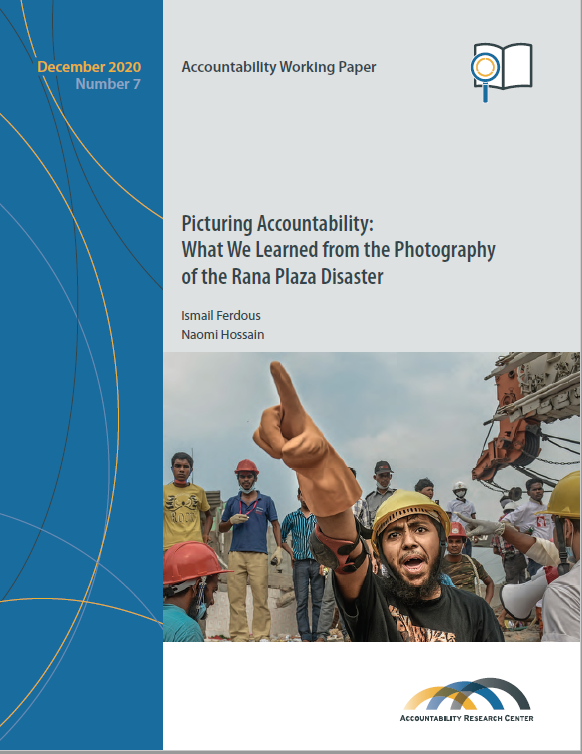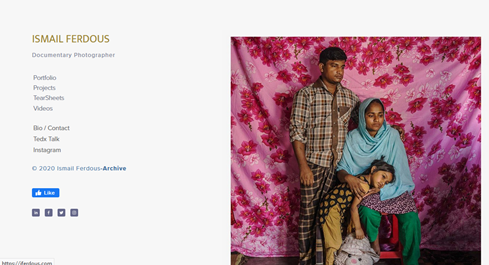
Picturing Accountability: What We Learned from the Photography of the Rana Plaza Disaster
Date: December 2020
Author(s): Ismail Ferdous and Naomi Hossain
Publication type: Working Paper
Published by: Accountability Research Center
Visual evidence can be a powerful part of strategies for pursuing accountability and social justice, and with the means of recording and viewing images now literally in our hands, we are becoming ever more sophisticated makers and users of visual evidence. This essay examines the role of photography in creating visual evidence in support of struggles for accountability. It draws on one photojournalist’s experience of photographing one of the worst industrial accidents in world history, the collapse of the Rana Plaza factory in Bangladesh in 2013, as well as its aftermath in the lives of those affected.
Visual evidence frames accountability demands because it can produce powerful emotional and moral responses to social injustice, as was seen in the response to the video of George Floyd’s murder; these responses make it possible to build solidarity across groups and geographies, as the Black Lives Matter movement showed. Yet activists have often struggled with precisely the problem of how to use images of pain and suffering, for fear of further victimizing their subjects or of inuring viewers to such images through their overuse or abuse. These are some of the thorny questions addressed here.
Among the key themes of this paper is that it matters not only what the images depict, but why they were produced, and by whom. Images that promote accountability through solidarity are not (just) digital commodities to be circulated to support a particular struggle; they are a form of testimony or witnessing that is rooted in fellowship and humanitarian principles. Yet while visual evidence can help frame and amplify accountability demands, pictures are rarely enough to hold the powerful to account.
Bangladeshi garments workers have continued to face violations of their labor rights, despite a series of efforts to improve factory safety by governments, trade unions, and firms since Rana Plaza. Most recently, workers and local firms have struggled to get paid for clothes they have already produced, as international brands have refused to pay up at a time when the COVID19 pandemic has led to economic crisis and falling fashion sales. Images of clothing labels in the rubble of Rana Plaza fingered the brands involved in sourcing garments in the unsafe building, and in so doing may have tarnished their reputations briefly; but they had no lasting impacts on those firms’ legal liability or profitability.
Visual evidence plays its main role in framing the demands for accountability, we argue, by identifying and allocating responsibility, making plain the scale or severity of the human costs for failures, and by raising awareness and questions about how systems fail and who pays the price. Pictures allow us to see the human face of the tragedy and to remember the need for change. Pictures also let us see garments workers as they organize and fight for their rights, reminding us that they are not helpless victims, but agents of their own empowerment, despite the (visibly) great odds against them.
Based on the analysis here, a collaboration between a photojournalist who photographed Rana Plaza and a researcher who studied the disaster, we propose that accountability research could usefully pay more attention to the visual, artistic and cultural repertoires so often involved in accountability struggles. There is much to learn about how visual repertoires have been deployed. Those who commission photography in the pursuit of social justice could valuably strengthen their relationships with visual activists and photographers, helping them build sustained engagement with frontline actors. Popular music, street art and video all appear to have had powerful framing and norm-shifting impacts in accountability struggles; in part this paper is a call for the transparency, participation, and accountability field to invest in better understanding of how visual evidence works in accountability struggles, and how it might empower those facing powerful opponents.
The ethics and politics of visual evidence are shifting fast with the social media age. Among the themes we address here are: how can activists on the frontlines of struggles for accountability navigate this terrain? What principles and practices are important?
 Rescue workers use clothes to bring down survivors and bodies after an eight-story building housing several garment factories collapsed in Savar, near Dhaka, Bangladesh, April 24, 2013.
Rescue workers use clothes to bring down survivors and bodies after an eight-story building housing several garment factories collapsed in Savar, near Dhaka, Bangladesh, April 24, 2013.
Ismail Ferdous is an award-winning photojournalist based in New York City whose work covers social and humanitarian issues. While still living in Dhaka, Bangladesh, he began the project The Cost of Fashion, a photo and video advocacy project after documenting the Rana Plaza factory collapse, the worst industrial disaster in history. He then continued working on the same issue with the After Rana Plaza project. The project continues to spread awareness about the fashion industry and its negative effects on workers in Bangladesh. Ismail has presented at Tedx Maastricht and his article about photojournalism was published in Harvard Magazine. He is a regular contributor to National Geographic and has photographed for The New York Times Magazine, The New York Times, The Washington Post, Bloomberg News, MSNBC Photo, and Associated Press. Ismail’s work has been exhibited at Photoville, United Nation headquarters, numerous Dysturb exhibitions, The Rencontres d’Arles, Photolux Festival Luca, The Gallatin Galleries NYU, Tokyo Photograph Art Museum, 25CPW Gallery New York, the World Bank headquarters, and the Powerhouse Museum, among others. Ismail’s work can be viewed here: https://iferdous.com/. Naomi Hossain is a political sociologist, who is currently a Research Professor at the Accountability Research Center in the School of International Service at American University in Washington DC. She was previously employed by BRAC Research and Evaluation Division in Bangladesh, and the Institute of Development Studies at the University of Sussex in the UK. Her research focuses on the politics of development, and she has written extensively about Bangladesh, disasters, protests, and women’s empowerment. She is the author of The Aid Lab: Understanding Bangladesh’s Unexpected Success (2017, Oxford University Press). Naomi’s work can be viewed here: https://nomhossain.com/.




